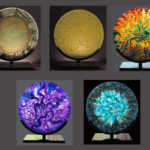When it comes to displaying your artwork effectively, a little lighting can go a long way. Whether you’re hanging prints in a narrow hallway or creating a gallery wall in your foyer, the lighting you choose will have a huge impact on how your art is viewed. The size and type of your room, the amount of natural light available, and the size of your art are all factors to consider when choosing lighting. Let’s look at six ways to create the perfect lighting so that you can really show off the pieces you love.
1. Choose lighting based on the room where artwork will be displayed.
Start off by taking a look at the room where you plan to display your artwork. Do you have a long and narrow space like a hallway or staircase? If so, you may require more directional track lighting than an open foyer or naturally lit living room. Gallery lights and LED panel lighting can make for a very chic look. Is the room big and bright? Spotlighting with can lights can provide task and ambient lighting at the same time. Consider using dimmer switches to give versatility depending on the time of day and your mood. You will be amazed at the difference it makes.
2. Select a lighting system that is flexible with your needs.
If your home gallery also serves as the media room or family room, the versatility of your lighting system becomes very important. For instance, you can adjust the direction of track lighting, and it can be spaced in varying intervals based on your artwork display—especially in homes where artwork is replaced frequently. A great example could be your children’s photos, which probably get swapped out yearly. The versatility of track lighting is pretty fantastic for these scenarios. You can light up all your cool artwork when you want to show it off, but enjoy total darkness for family movie nights.
3. Take advantage of the natural light whenever possible.
Who doesn’t love lots of natural light? Open windows, skylights and adjacent rooms that have natural and borrowed light are an asset when selecting gallery lighting. Natural lighting provides the best light for artwork to be displayed throughout your home, although direct sunlight should be avoided to preserve the integrity of your artwork.
4. All lighting isn’t created equal.
Remember, when choosing lighting for your art gallery, the color of light that illuminates your artwork can be more important than the fixture. Choosing lighting with good, clean color-rendering qualities will help your artwork display in its truest colors. When shopping for lighting, consider asking a lighting professional to help you choose just the right lighting for your specific medium of artwork. You will find that most recommend LED lighting for sustainability and to protect your art from damage by more harmful types of lighting.
5. Choose artwork lighting before the ambient lighting.
To ensure that your artwork is lit properly, choose the fixtures that shine on the art first. This will ensure that the surrounding or ambient lighting isn’t too harsh or too dull. The right ratio between ambient and task lighting can create a gorgeous viewing experience.
6. Position lighting according to the size of your artwork.
Keep in mind where the lighting is positioned in relation to the surface of the artwork. Larger artwork can benefit from a lighting fixture positioned farther away or from a beam of light that evenly distributes across the entire canvas. For smaller pieces, closer lighting often works well.
Are you still stumped on how to best light your artwork? Consider hiring a lighting professional who is experienced in gallery lighting to help you create the perfect look. Inspired LED also offers free lighting design services for all of your lighting needs!
Laurie Laizure is the CEO of Customized Walls and founder of the largest online community for design pros, Interior Design Community. Laurie’s work has been featured on HGTV, Food Network, Bravo, and Hulu Plus and also seen in New England Home and Country Living magazines. She also writes on her own blog, William Sonoma Designer Marketplace and for Shutterfly.com. Connect in with her here: Google+




